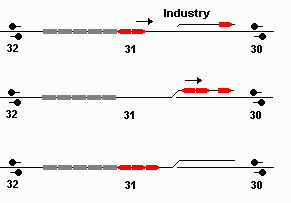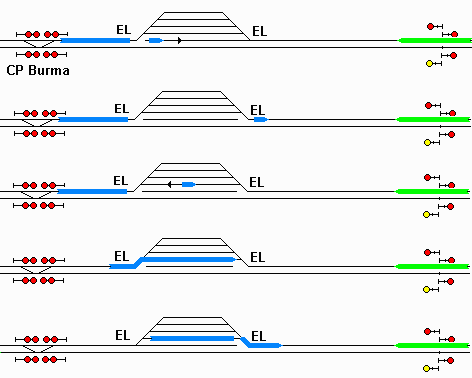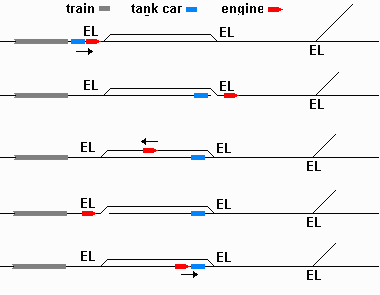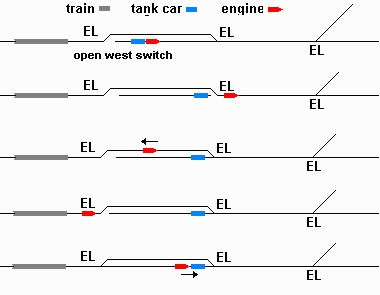
GCOR Electric Locked hand operated switch rule A situation occurred the other day involving hand operated electric locked switches in CTC. There is some dispute over the exact interpretation of the applicable rules.
9.17 Entering a main track at a hand operated switch.
Within CTC territory the control operator must authorize the train to enter the track at a hand operated switch where no governing signal exists.9.18 Electrically Locked Switches.
To enter a track within CTC limits, employees must not open the door of case or unlock an electrically locked switch without authority from control operator.
It seems straightforward enough. But... What is the meaning of the word Enter? If I enter a room and I move around in that room, can I enter a room I am already occupying?
Senario #1, Picking up a loco using the road power. I am on a train on single track CTC out in the boonies. There is an industry track a few carlengths long with a facing point electric lock hand throw switch. There is a single loco parked in that track and I have to stop and pick it up. It is headed the correct direction so I want to MU it to the point as a new lead unit. I stop my train at the facing point switch. The conductor unlocks the electric lock and lines the switch for the industry track. We tie the train down on the main and cut the power off. We pull our power a few car lengths into the industry track and couple to the single unit. We MU it and do the air test then we back all the units out onto our train. We close and lock the switch.

Have we violated Rule 9.17? With our train parked on the main and the switch opened to run our power into the industry track and left open while the power is in there, when we back out onto our train have we entered a main track at a hand operated switch? We were already in the room. Our train was on the main line in that block. Our officers and rules people agree with that. No rule was violated.
Have we violated Rule 9.18? Have we unlocked an electrically locked switch "to enter a track within CTC limits"? You can read Rule 9.18 two ways.
- "To enter a track within CTC limits" means to enter a track that has a CTC signal system on it. In the senario above you are not entering a track in CTC limits when you exit the main and go into the unsignaled industry track. So you do not need authority to unlock the switch and enter the industry track. Our officers and rules people say that this move is perfectly ok. No rule was violated. So they are interpreting Rule 9.18 in this manner.
- "To enter a track within CTC limits" means to enter ANY track while your train is within CTC limits (territory). If you use this second interpretation of "To enter a track within CTC limits" then clearly the move I described above was against the rule. Since it is said not to be against the rule this interpretation is not the correct one.
Senario #2, Picking up a loco by walking to it. The next time we do it slightly different. We stop at the switch, unlock it, and line it for the industry track. Then instead of cutting off our power and pulling into the industry track, I get off and walk 10 carlengths to the single unit parked there. I get on the unit and run it out the open switch and couple onto the front of our original power.

Have we violated Rule 9.17? With our train parked on the main and the switch opened when I back out onto our train have I entered a main track at a hand operated switch? We were already in the room. Our train was on the main line in that block.
Have we violated Rule 9.18? Have we unlocked an electrically locked switch "to enter a track within CTC limits"?
Most crews and any thinking person would say the two moves are the same thing. You unlocked and opened the switch while your own train was stopped on the main in the block. It does not matter whether you run your own power into the industry track to pick up the new unit or whether you back that unit out onto your original power. If you believe that interpretation then read on. If you disagree with that interpretation then you are one of the few and go surf the web elsewhere.
Senario #3 A westbound train (green) was stopped on the CTC main east of CP Burma and east of the west yard switch. An eastbound train (blue) was stopped west of CP Burma.

The blue train had to get into the yard before the green train could crossover at CP Burma and depart. The dispatcher ascertained verbally that the green train was indeed stopped and then he talked the blue train past the red absolute at CP Burma.
At this point there is some discrepancy. The blue crew says the dispatcher did not tell them specifically WHERE to head in into the yard. But it was generally assumed by both train crews that the blue train would head in at the west yard switch. There was no other way to do it.
That switch is a hand throw switch with an electric lock. On BNSF and by GCOR itself you do not need authority to open an electric lock switch to go IN. You do need authority to open it to come OUT. The operative words are: "...to ENTER a main track...".
The blue train proceeded through the crossovers at CP Burma and then unlocked and opened the yard switch. They then pulled into the yard.

The blue train did not fit on the yard track so they had to double their train over into another track. To double over they unlocked the electric lock and opened the east yard switch then pulled out onto the main. Note that the block is still occupied at the west switch by the blue train.

The blue train continued forward far enough to get their rear end in the clear at the west switch.

The green train got a signal at CP Burma to depart westbound. The blue train made a cut in their train, pulled forward to clear the ladder track then shoved the head portion of their train into the clear on another yard track.
While the blue train is doubling over the green train cleared CP Burma. The dispatcher noticing that the green train has departed to the west wonders about a track occupancy light still lit up on the main east of CP Burma. Is there a broken rail out there? Did the green train leave part of his train?

No, he finds out that the blue train is doubling over into the yard at the east yard switch. The hammer comes down. He wants to know how they got out there? The crew is charged with a rule violation and it is treated as if they had failed an efficiency test.
The crew (and others) maintain that they could come out that switch without further authority. They maintain that they were not "entering a main track" since they never cleared the main in the first place. The west yard switch was open and the rear end of their train hanging out on the main when they had unlocked and opened the east switch. Both switches and all of their train at all times was within the same block. You cannot enter a room that you are already in, therefore they did not enter a track within CTC limits at an electric lock switch. The crew feels they did not violate the rule.
My question to you rules guru's is who is right?
Under GCOR Rule 6.4.1 (on BNSF) you can make a reverse movement within the same block without any dispatcher authority. In fact you can make forward and reverse moves all day as long as you are within one block, never passing a signal. That is how you switch industries or make set outs and pick ups. You don't ask for authority to change direction at every single move. You'd never get the work done and the dispatcher would get peeved at you quite quickly. This implies that unless the dispatcher or other instructions put further restrictions on you, you have authority once in a block to do what you need to do in that block. (All of it at Restricted Speed of course).
See related Union Pacific question.There is some evidence that the dispatcher thought the green train, to stay clear of crossings, had stopped back further east than it actually had. If the green train had stopped farther east then there would have been no reason why the blue crew could not have pulled their entire train east of the east yard switch and backed it into the yard. (The dispatcher did not tell them WHERE to enter the yard).

Had they done that then they would have been perfectly legal in opening the east electric lock switch to back in. It is the same thing as Senario #1 above which has been deemed legal by our officers. And having it open then they would have been perfectly legal doubling the head end over. So my question, and most other train crews' question, is what the heck is the difference between that and what actually occurred?
What would have happened had the green train been stopped farther east and the blue train had cut its train off on the main just barely west of the west yard switch. Then after moving the power over the west yard switch, with the switch sandwiched between the blue train and the blue train's power, they opened the west yard switch. Then proceeded east on the main with the power to the east yard switch. There they could open the east switch and back the power through the yard to west switch. Re-couple to the train and pull it in and double over out the east switch which was left open? Is there anything illegal about that? Not that I know of.

At the safety meeting held to discuss the crew's failure one possible problem that could have occurred with the crew doing it the way they actually did was postulated. If the dispatcher had indeed believed the green train had stopped farther east rather than where it actually had stopped between switches, then if that green train had requested a BACK UP MOVE to pick up their conductor for some reason, there is going to be a collision. A back up move is a blind shove. The green train would have backed into the side of the blue train while it was doubling over at the east switch. Ouch!
But a dispatcher cannot give permission for a back up move if another train has authority in the same limits. At least not until the dispatcher has positively determined exactly where each train is. So I don't believe that argument is valid.
Others have postulated that the dispatcher may have authorized a third train into the block behind the green train or even MOW. It doesn't matter. That train would have to be operating at Restricted Speed because of the red intermediate. If MOW it would have to be joint with the blue train. He can't use the green train as protection for the MOW from the blue train. There is no guarentee that the green train won't clear the main for some reason which would let the third train pass it. For instance suppose the green train was a local switching an industry east of the east yard switch. When they finish they pull to the east yard switch and head into the yard clearing the main. Then that 3rd train is going to be first out. But it still doesn't matter since all trains and MOW should be operating at Restricted Speed.
The whole thing is real mess. The railroad is maintaining that ANYTIME you open an electric lock switch to ENTER a main track you need authority from the control operator (dispatcher). None of us deny that. The question is how you interpret the meaning of "Entering a main track". Crews say they are not ENTERING since they are already occupying the main? You cannot enter a room that you are already in.
Senario #4, Running around cars. This strict interpretation tells me that I, and every other crew I have talked to, have been in violation of this rule at Hardin, MT for years.We frequently get tank cars to set out on the Hardin North line. These cars come from the west but the North Line switch is a facing point switch which opens to the west. So we have to run around the cars before we can shove them out the North Line. We use the old Hardin Train Order siding to do that. It has hand throw electric locked switches on both ends. With our electric locks if you are on the main and occupy the track just beyond the points you can unlock the electric locks without having to wait for the 7 minute time out. If you are not within a few feet of the switch or are not on the main then it does have to time out. All of these switches and all of the switching is done within one intermediate CTC block.
We stop our train at the west switch and cut the tank cars and power off the train. At this point there are several ways to do it.
(A) Illustrated below. You can pull the tanks to just west of the east switch and leave them on the main. Take the power just east of the east switch, open it, run around the cars through the old siding back to the west switch. To get out onto the main you have to unlock the electric lock and wait the 7 minutes for it to time out then open the switch and come out. Close the switch and run east on the main until you couple into the tanks. Then you can shove them to spot.

(B) Not illustrated. After cutting off from the train you can open the west electric lock switch. No waiting because you are on the main at the switch. Pull the cars east on the siding and leave them in the clear on the east end. Unlock the east electric lock and wait the 7 minutes for it to time out. Open the east switch and come out with the power then run west up the main to the west switch. Go in the west switch and go east through the siding again to couple onto the cars at the east end. Shove them out the east switch (which was left unlocked from before) and spot the cars.
(C) It didn't take us long after the installaton of CTC to realize that both methods A and B above required us to wait for one of the electric locks to time out. Method C does not. You do as you did for method A above. Except this time when you first cut off the train you unlock the electric lock on the west switch. You don't have to wait for it to time out because the locos are sitting on the main at the switch. It doesn't really matter though since you are not going to actually throw the switch at this time. Just unlock the electric lock. The rest of the procedure is the same as in method A. But when you get back to the west switch you don't have to unlock it and wait for it to time out this time because you already unlocked it when you cut off the train. You have saved 7 minutes.

Let's go back to Senario #2. The one where I walked up to the loco and backed it out onto my consist which was sitting on the main. According to the officers and rules people I have just commited a cardinal sin. I ENTERED a main track at an electric lock hand throw switch without authority. Remember that Senario #1 was perfectly legal, but #2 is not. This... in my humble opinion, people... is ASSININE!In senario #4 clearly under the current strict interpretation of the electric lock rules we had been violating those rules when ever we used method A or B. Because in both methods we unlocked and opened an electric lock switch while on the siding then moved out onto the main line. We ENTERed the main at an electric lock switch without authority according to their interpretation. This is getting mighty darn picky though since in method A our train is sitting on the main just a few car lengths away or in method B our train is sitting on the main in the same block.
If we use method C I am still not positive as to whether we have violated the electric lock rules or not under the current strict interpretations? As you will see later, however, I tend to believe they think we would be. So from now on when ever I have to switch Hardin, dispatchers take note, I am going to request authority to use ALL THREE of the electric lock switches at Hardin until we are ready to depart.
Conclusion As I said in the beginning of this discussion, it all hinges on the interpretation of "entering a track". If you use the broad interpretation of it you end up with ridiculous side effects such as those described here. If however you use the interpretation that to "enter a track" means only the initial entry of your authority limits that are not currently or continuously occupied by your train, then all of these problems and idiocies go away. There is no danger in using that interpretation. If the track to be used is already occupied by your train then it is protected. No other train operating by the rules would ever collide with it.
The sole purpose of Rule 9.18 as I see it is to prevent delaying other traffic and to prevent dropping signals in the face of other trains. If you operate an electric lock in an unoccupied block without permission you can drop signals in front of approaching trains. You canNOT cause a collision however. The electric lock itself prevents you from opening the switch in front of an approaching train. That is what it is there for. If on the other hand you operate an electric lock in a block which is occupied and has been legally occupied and continuously occupied, there is no danger.
The problem of interpretation of the word ENTER has come up in several other discussions of rules. Every time it is interpreted to mean something other than the "INITIAL occupying of the authority limits" it causes problems. If you are already in the room you cannot "enter" the room. If you are already in your authority limits you cannot "enter" those limits. I don't believe the authors of the GCOR meant for the word enter to be interpreted in any other way. The rules work if you stick to that one meaning of the word. If you use a broader definition of the word enter then it often presents dualities like this one. In one situation you have to interpret the words one way and in another situation you have to interpret those same words in a different manner.




| Return to Tales index | My Home Page | E-Mail me |
Created 06-20-2002
Updated 08-03-2002